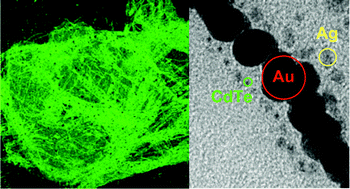Stepwise interfacial self-assembly of nanoparticlesvia specific DNA pairing†
Abstract
In the present work, we succeeded in alternatively depositing

* Corresponding authors
a
Department of Polymer Science and Engineering, Zhejiang University, Hangzhou, P. R. China
E-mail:
cygao@mail.hz.zj.cn
Fax: +86 571 87951948
b
Max Planck Institute of Colloids and Interfaces, Potsdam, Germany
E-mail:
dayang.wang@mpikg-golm.mpg.de
Fax: +49 331 5679202
c Department of Chemistry, Zhejiang University, Hangzhou, P. R. China
d Center of Advanced European Studies and Research, Bonn, Germany
In the present work, we succeeded in alternatively depositing

 Please wait while we load your content...
Something went wrong. Try again?
Please wait while we load your content...
Something went wrong. Try again?
B. Wang, M. Wang, H. Zhang, N. S. Sobal, W. Tong, C. Gao, Y. Wang, M. Giersig, D. Wang and H. Möhwald, Phys. Chem. Chem. Phys., 2007, 9, 6313 DOI: 10.1039/B705094A
To request permission to reproduce material from this article, please go to the Copyright Clearance Center request page.
If you are an author contributing to an RSC publication, you do not need to request permission provided correct acknowledgement is given.
If you are the author of this article, you do not need to request permission to reproduce figures and diagrams provided correct acknowledgement is given. If you want to reproduce the whole article in a third-party publication (excluding your thesis/dissertation for which permission is not required) please go to the Copyright Clearance Center request page.
Read more about how to correctly acknowledge RSC content.
 Fetching data from CrossRef.
Fetching data from CrossRef.
This may take some time to load.
Loading related content
